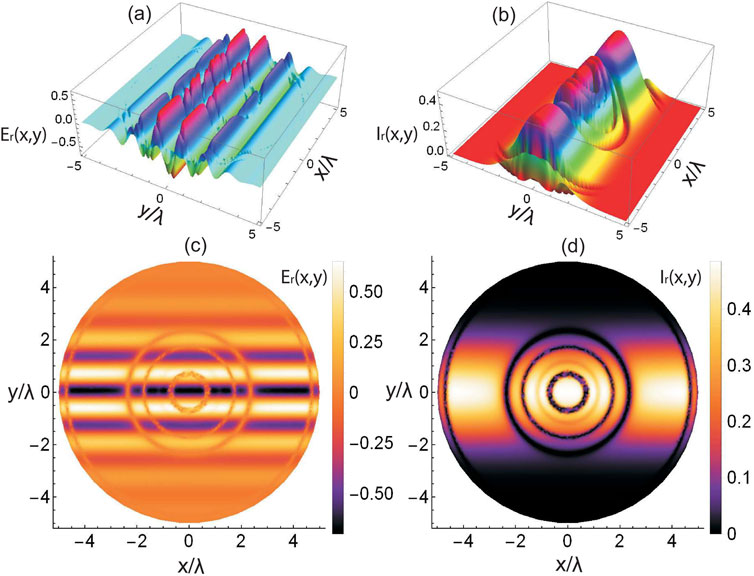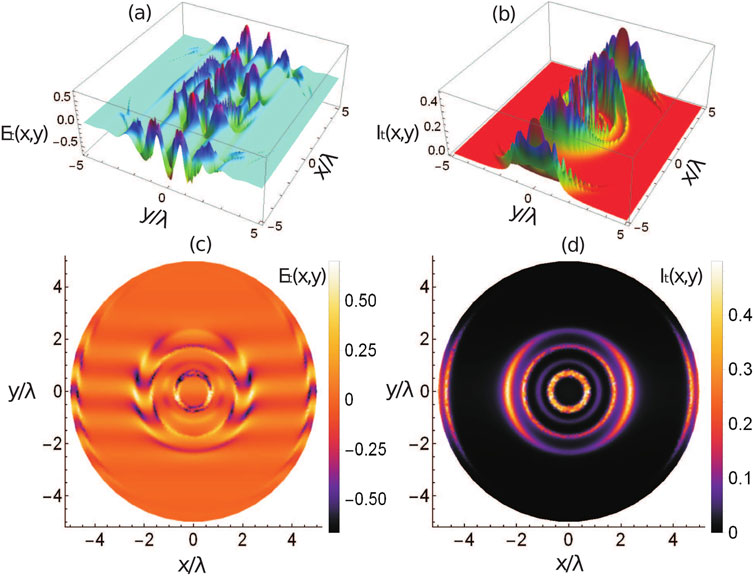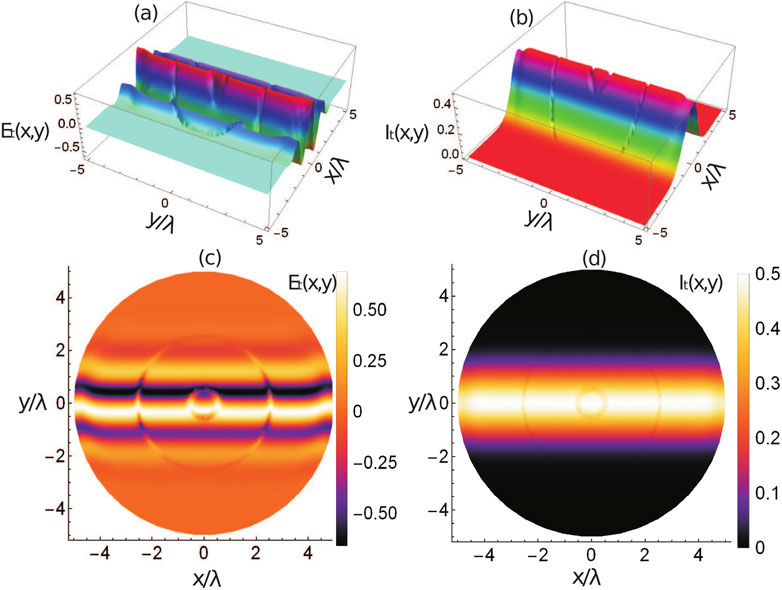- 1 Department of Mathematics, College of Sciences, Northern Border University, Arar, Saudi Arabia
- 2 Sustainability Competence Centre, Széchenyi István University, Győr, Hungary
- 3 Department of Mathematics, College of Sciences and Arts (Muhyil), King Khalid University, Muhyil, Saudi Arabia
- 4 Department of Physics, University of Malakand, Chakdara, Pakistan
- 5 Department of Mathematics, University of Malakand, Chakdara, Pakistan
The generation of spatial bright solitons of reflection and transmission pulses and their intensities are investigated in a sodium atomic medium using Gaussian Milnor polynomial control fields. Significant bright and dark ring-shaped solitons are controlled by balancing nonlinearity and dispersion along two spatial coordinates. The intensity is more localized along one of the spatial coordinates due to larger nonlinearity and spread along other spatial coordinates due to smaller nonlinearity in the reflection pulse. A circular, crater-type bright soliton intensity is also maintained around the origin of the x and y coordinates, exhibiting varying intensity along the circumference. A large, bright intensity peak is observed around the origin, with the intensity minima at the center in reflection. The intensity peaks are enhanced in one of the spatial coordinates and localized in another coordinate in reflection. A large Gaussian-type bright solitonic intensity distribution is investigated at approximately
1 Introduction
Solitons are spatial waves that stay together as they travel because the medium’s nonlinearity and spreading effects cancel each other out. The word “soliton” is used for a wave that looks like a single, short pulse that can pass through another similar pulse without changing its shape or speed [1]. They occur in various physical systems, such as fluids [2], optical fibers [3, 4], plasmas [5], condensed matter systems [6], acoustic media [7], and gravitational systems [8, 9]. Solitons have some key properties that distinguish them from other wave phenomena. Among these properties, shape preservation [10], stable propagation [11, 12], elastic collisions [13], stability [11], localized energy [15], nonlinear nature [16, 17], and robustness [18] are the most prominent. Solitons remain stable when the spreading effect (dispersion or diffraction) and the medium’s nonlinearity cancel each other out at a certain level of the applied control field [19]. Because of this balance, strong solitons can withstand disturbances such as fluctuations in light intensity or phase noise.
The history of solitons spans several centuries and involves contributions from multiple fields of science and mathematics. Early studies of waves in various media—such as the motion of water waves—laid the groundwork for understanding the wave behavior. However, the concept of a soliton had not yet formed in the early
Solitons have many types based on the physical systems in which they occur and the nature of the balance between nonlinearity and dispersion. The main types are bright solitons [29], dark solitons [30], vortex solitons [31], breathers [32], sine-Gordon solitons [33], and Korteweg–de Vries solitons [34], among others. Spatial bright solitons are self-trapped light beams that can travel through a nonlinear medium without spreading out. They form when the medium’s refractive index increases with light intensity, focusing the beam and balancing diffraction [35]. Solitons in the presence of Milnor polynomials involve studying soliton solutions within systems influenced by the structure of Milnor polynomials. Milnor polynomials arise in singularity theory and are used to describe the behavior of complex systems near critical points or singularities. When applied to nonlinear systems, these polynomials can introduce new potential landscapes that affect soliton dynamics. Solitons have applications in diverse fields of science and technology. The concept of solitons finds applications across a wide range of disciplines, such as optical communications [36–38], plasma physics [39], laser physics [40, 41], fluid dynamics [42, 43], magnetism, semiconductor and materials science [44, 45], chalcogenide glasses [46], nerve impulses [47, 48], fiber optics [49], optical computation [50], signal processing [51], radar technology [52], microcomb range measurement [53], and artificial neural networks [54].
In this work, we study the generation of spatial bright solitons of reflection and transmission pulses and their intensities in a sodium atomic medium using control fields of Gaussian Milnor polynomial. A significant gap in the study of optics will be filled by the updated result.
2 Model of the atomic system and its susceptibility
The sodium atomic system as shown in Figure 1, has a ground state
The optical behavior of this atomic arrangement interacting with the probe and the three control fields is examined by analyzing its response. The Hamiltonian for the sodium atomic system is constructed in the interaction picture, employing the dipole approximation and the rotating wave approximation, in order to derive the required atomic susceptibility.
The Hamiltonian representing the configuration in the absence of external interactions is expressed as follows:
The Hamiltonian governing the system’s dynamics in the interaction picture is expressed as follows:
Equations 1, 2 represent the complete Hamiltonian of the system. The dynamics of the atomic system in the Heisenberg picture are governed by the density matrix formalism, which is calculated as follows:
In Equation 3,
In Equation 4,
To introduce cross Kerr nonlinearity in
where
The Rabi frequencies of the control light fields in the form of Gaussian Minor polynomial are written as follows:
In Equations 6–8,
where, in Equation 9,
Equation 10 represent the dipole matrix element. The group index characterizing the medium can be expressed as follows:
where, in Equation 11,
The group index expression in Equation 12, show the fast or slow propagation of solitons waves. The reflection and transmission are written as follows:
where, in Equations 13, 14 the terms
At the plane
where, in Equation 15 the term “A” is described as
The mathematical expressions for the transmitted and reflected pulses are given below.
In Equations 16, 17,
3 Results and discussion
The results are presented to demonstrate the generation of spatial bright solitons for both the reflected and transmitted pulses, as well as their corresponding intensities. This is achieved by applying control fields that have a shape described by a Gaussian Milnor polynomial within a sodium atomic medium. A decay rate of
In Figure 2, the charts depict the reflection pulse and reflection pulse intensity against wavelength-normalized

Figure 2. Reflection pulse and reflection pulse intensity versus the spatial axes
The graphs in Figure 3 visualize the transmission pulse and transmission pulse intensity against wavelength-normalized

Figure 3. Transmission pulse and transmission pulse intensity versus wavelength-normalized
In Figure 4, illustrations are presented for the reflection pulse and reflection pulse intensity against wavelength-normalized

Figure 4. Reflection pulse and reflection pulse intensity versus wavelength-normalized
Figure 5 presents the illustrations for the transmission pulse and transmission pulse intensity versus the spatial coordinates

Figure 5. Transmission pulse and transmission pulse intensity versus wavelength-normalized
4 Conclusion
The formation of spatial bright solitons in the reflected and transmitted pulses, along with their intensities, is examined in a sodium atomic medium by applying control fields shaped as Gaussian Milnor polynomials. A four-level sodium atomic system is driven by a weak probe field and three control fields, with the control fields having the Gaussian Milnor polynomial profile, to control and tune the bright and dark solitons in the reflected and transmitted beams. The density matrix formalism is utilized to calculate the electric susceptibility of the medium, and the dielectric function is derived from it. The reflection and transmission coefficients are determined using this dielectric function. These coefficients are then used to obtain the reflected and transmitted pulses and their respective intensities. Finally, the behavior of the reflected and transmitted pulses and their intensities is analyzed by plotting them against spatial coordinates normalized to the free-space wavelength of light. Significant bright and dark ring-shaped solitons are controlled by balancing nonlinearity and anomalous/normal dispersion along the two spatial coordinates. The intensity is more localized along one of the spatial coordinates due to larger nonlinearity and spread along other spatial coordinate due to smaller nonlinearity in the reflection pulse. A circular crater-type bright soliton intensity is also controlled around the origin of the x and y coordinates, having varying intensity at the circumference length. A large bright intensity peak around the origin is investigated, which has intensity minima at the center in the reflection. The intensity peaks are enhanced in one of the spatial coordinates and localized in the other coordinate in reflection. A large Gaussian-type bright solitonic intensity distribution is investigated at approximately
Data availability statement
The raw data supporting the conclusions of this article will be made available by the authors, without undue reservation.
Author contributions
FA: Conceptualization, Investigation, Methodology, Validation, Visualization, Writing – original draft. DP: Conceptualization, Data curation, Funding acquisition, Investigation, Project administration, Supervision, Validation, Writing – review and editing. MD: Conceptualization, Formal Analysis, Methodology, Software, Validation, Writing – original draft. AM: Conceptualization, Data curation, Formal Analysis, Investigation, Methodology, Validation, Visualization, Writing – original draft. AA: Conceptualization, Formal Analysis, Investigation, Software, Supervision, Writing – review and editing.
Funding
The author(s) declare that financial support was received for the research and/or publication of this article.
Acknowledgments
The authors extend their appreciation to the Deanship of Research and Graduate Studies at King Khalid University for funding this work through Large Research Project under grant number “RGP. 2/145/46”, the authors also express their appreciation to the Deanship of Scientific Research at Northern Border University, Arar, Saudi Arabia for funding this research work through project number “NBU-FFR-2025-1324-04”.
Conflict of interest
The authors declare that the research was conducted in the absence of any commercial or financial relationships that could be construed as a potential conflict of interest.
Generative AI statement
The author(s) declare that no Generative AI was used in the creation of this manuscript.
Any alternative text (alt text) provided alongside figures in this article has been generated by Frontiers with the support of artificial intelligence and reasonable efforts have been made to ensure accuracy, including review by the authors wherever possible. If you identify any issues, please contact us.
Publisher’s note
All claims expressed in this article are solely those of the authors and do not necessarily represent those of their affiliated organizations, or those of the publisher, the editors and the reviewers. Any product that may be evaluated in this article, or claim that may be made by its manufacturer, is not guaranteed or endorsed by the publisher.
References
1. Scott AC, Chu FY, McLaughlin DW. The soliton: a new concept in applied science. Proc IEEE (1973) 61(10):1443–83. doi:10.1109/proc.1973.9296
2. Gottwald G, Grimshaw R, Malomed BA. Stable two-dimensional parametric solitons in fluid systems. Phys Lett A (1998) 248(2-4):208–18. doi:10.1016/s0375-9601(98)00658-6
3. Mollenauer LF, Gordon JP. Solitons in optical fibers: fundamentals and applications. Elsevier (2006).
4. Hasegawa A, Kodama Y. Guiding-center soliton in optical fibers. Opt Lett (1990) 15(24):1443–5. doi:10.1364/ol.15.001443
5. Ichikawa YH. Topics on solitons in plasmas. Physica Scripta (1979) 20(3-4):296–305. doi:10.1088/0031-8949/20/3-4/002
6. Bishop AR, Krumhansl JA, Trullinger SE. Solitons in condensed matter: a paradigm. Physica D: Nonlinear Phenomena (1980) 1(1):1–44. doi:10.1016/0167-2789(80)90003-2
7. Ewen JF, Gunshor RL, Weston VH. An analysis of solitons in surface acoustic wave devices. J Appl Phys (1982) 53(8):5682–8. doi:10.1063/1.331454
9. Villatoro FR. Nonlinear gravitational waves and solitons. Nonlinear systems. Math Theor Comput Methods (2018) 1:207–40. doi:10.1007/978-3-319-66766-9_7
10. Wang L, Gao YT, Meng DX, Gai XL, Xu PB. Soliton-shape-preserving and soliton-complex interactions for a (1+ 1)-dimensional nonlinear dispersive-wave system in shallow water. Nonlinear Dyn (2011) 66:161–8. doi:10.1007/s11071-010-9918-9
11. Tao T. Why are solitons stable? Bull Am Math Soc (2009) 46(1):1–33. doi:10.1090/s0273-0979-08-01228-7
12. Enns RH, Rangnekar SS, Kaplan AE. Bistable-soliton pulse propagation: stability aspects. Phys Rev A (1987) 36(3):1270–9. doi:10.1103/physreva.36.1270
13. Darvishi MT, Kavitha L, Najafi M, Kumar VS. Elastic collision of Mobile solitons of a (3+ 1)-dimensional soliton equation. Nonlinear Dyn (2016) 86:765–78. doi:10.1007/s11071-016-2920-0
15. Timm L, Weimer H, Santos L, Mehlstaubler TE. Energy localization in an atomic chain with a topological soliton. Phys Rev Res (2020) 2(3):033198. doi:10.1103/physrevresearch.2.033198
16. Kartashov YV, Malomed BA, Torner L. Solitons in nonlinear lattices. Rev Mod Phys (2011) 83(1):247–305. doi:10.1103/revmodphys.83.247
17. Ali A, Ahmad J, Javed S. Exploring the dynamic nature of soliton solutions to the fractional coupled nonlinear schrodinger model with their sensitivity analysis. Opt Quan Electronics (2023) 55(9):810. doi:10.1007/s11082-023-05033-y
18. Menyuk CR. Soliton robustness in optical fibers. JOSA B (1993) 10(9):1585–91. doi:10.1364/josab.10.001585
19. Ullah I, Majeed A, Ali A, Khan ZA. Reflection and transmission solitons via high magneto optical medium. Chaos, Solitons and Fractals (2025) 191:115881. doi:10.1016/j.chaos.2024.115881
20. Korteweg DJ, De Vries G. XLI. On the change of form of long waves advancing in a rectangular canal, and on a new type of long stationary waves. The Lond Edinb Dublin Philosophical Mag J Sci (1895) 39(240):422–43. doi:10.1080/14786449508620739
21. Russell JS, Report on waves: made to the meetings of the British association in 1842-43, (1845).
23. Zabusky NJ, Kruskal MD. Interaction of “solitons” in a collisionless plasma and the recurrence of initial states. Phys Rev Lett (1965) 15(6):240–3. doi:10.1103/physrevlett.15.240
25. Piekara A. 6A7-On self-trapping of a laser beam. IEEE J Quan Electronics (1966) 2(8):249–50. doi:10.1109/jqe.1966.1074035
26. Zhou G, Xu J, Hu H, Liu Z, Zhang H, Xu C, et al. Off-axis four-reflection optical structure for lightweight single-band bathymetric LiDAR. IEEE Trans Geosci Remote Sensing (2023) 61:1–17. doi:10.1109/tgrs.2023.3298531
27. Luo K, Fu Q, Liu X, Zhao R, He Q, Hu B, et al. Study of polarization transmission characteristics in nonspherical media. Opt Lasers Eng (2024) 174:107970. doi:10.1016/j.optlaseng.2023.107970
28. Dong C, Fu Q, Wang K, Zong F, Li M, He Q, et al. The model and characteristics of polarized light transmission applicable to polydispersity particle underwater environment. Opt Lasers Eng (2024) 182:108449. doi:10.1016/j.optlaseng.2024.108449
29. Khaykovich L, Schreck F, Ferrari G, Bourdel T, Cubizolles J, Carr LD, et al. Formation of a matter-wave bright soliton. Science (2002) 296(5571):1290–3. doi:10.1126/science.1071021
30. Kivshar YS, Luther-Davies B. Dark optical solitons: physics and applications. Phys Rep (1998) 298(2-3):81–197. doi:10.1016/s0370-1573(97)00073-2
31. Malomed BA. Vortex solitons: old results and new perspectives. Physica D: Nonlinear Phenomena (2019) 399:108–37. doi:10.1016/j.physd.2019.04.009
32. Yu M, Jang JK, Okawachi Y, Griffith AG, Luke K, Miller SA, et al. Breather soliton dynamics in microresonators. Nat Commun (2017) 8(1):14569. doi:10.1038/ncomms14569
33. Davidson A, Dueholm B, Kryger B, Pedersen NF. Experimental investigation of trapped sine-Gordon solitons. Phys Rev Lett (1985) 55(19):2059–62. doi:10.1103/physrevlett.55.2059
34. Pomeau Y, Ramani A, Grammaticos B. Structural stability of the Korteweg-de vries solitons under a singular perturbation. Physica D: Nonlinear Phenomena (1988) 31(1):127–34. doi:10.1016/0167-2789(88)90018-8
35. Stegeman GI, Segev M. Bright spatial soliton interactions. In: Optical solitons: theoretical challenges and industrial perspectives: Les Houches Workshop (1999). 313–34. Berlin, Heidelberg: Springer Berlin Heidelberg.
36. Haus HA, Wong WS. Solitons in optical communications. Rev Mod Phys (1996) 68(2):423–44. doi:10.1103/revmodphys.68.423
37. Doran N, Blow K. Solitons in optical communications. IEEE J Quan Electron (1983) 19(12):1883–8. doi:10.1109/jqe.1983.1071806
38. Palai G, Nayyar A, Manikandan R, Singh B. Metamaterial based photonic structure: an alternate high performance antireflection coating for solar cell. Optik (2019) 179:740–3. doi:10.1016/j.ijleo.2018.10.216
39. Shukla PK. Solitons in plasma physics. Nonlinear Waves (1983) 197–221. doi:10.1017/CBO9780511569500.012
40. Bullough RK, Jack PM, Kitchenside PW, Saunders R. Solitons in laser physics. Physica Scripta (1979) 20(3-4):364–81. doi:10.1088/0031-8949/20/3-4/011
41. Bohora R, Yadav K, Dhobi SH. Differential cross-sections and energy shifts in electron-atom scattering under linearly polarized laser fields. J Opt Photon Res (2024) 2(2):86–92. doi:10.47852/bonviewjopr42023979
42. Ozkan A. On the soliton solutions of some time conformable equations in fluid dynamics. Int J Mod Phys B (2024) 38(02):2450027. doi:10.1142/s0217979224500279
43. Wang H, He Q, Yuan S, Zeng W, Zhou Y, Tan R, et al. Magnetic field sensor using the magnetic fluid-encapsulated long-period fiber grating inscribed in the thin-cladding fiber. J Opt Photon Res (2023) 1(4):210–5. doi:10.47852/bonviewjopr32021689
44. Kosevich AM, Ivanov BA, Kovalev AS. Magnetic solitons. Phys Rep (1990) 194(3-4):117–238. doi:10.1016/0370-1573(90)90130-t
45. Palai G. Realization of temperature in semiconductor using optical principle. Optik (2014) 125(20):6053–7. doi:10.1016/j.ijleo.2014.07.078
46. Palai G. Measurement of impurity concentration in chalcogenide glasses using optical principle. Optik (2014) 125(19):5794–9. doi:10.1016/j.ijleo.2014.07.004
47. Priya R, Kavitha L. Solitons in nerve axons. Mater Today Proc (2022) 51:1782–7. doi:10.1016/j.matpr.2021.04.060
48. Al-Taie MSJ. The mutual support between bright and dark pulses in photonic crystal fibers. J Opt Photon Res (2025). doi:10.47852/bonviewjopr52024590
50. Sreelatha KS, Parameswar L, Joseph KB. Optical computing and solitons. In: AIP conference proceedings American institute of physics, 1004 (2008). p. 294–8.
52. Sheerin JP, Nicholson DR. Theory of radar detection of solitons during ionospheric heating. Phys Lett A (1983) 97(9):395–8. doi:10.1016/0375-9601(83)90673-4
53. Suh MG, Vahala KJ. Soliton microcomb range measurement. Science (2018) 359(6378):884–7. doi:10.1126/science.aao1968
Keywords: bright solitons, Milnor polynomials, reflection, transmission, control fields
Citation: Al Samman FM, Pamucar D, Dalam MEE, Majeed A and Ali A (2025) Coherent manipulation of spatial bright solitons of reflection and transmission using control fields of Milnor Gaussian polynomials. Front. Phys. 13:1666771. doi: 10.3389/fphy.2025.1666771
Received: 15 July 2025; Accepted: 08 September 2025;
Published: 08 October 2025.
Edited by:
Yudong Cui, Zhejiang University, ChinaCopyright © 2025 Al Samman, Pamucar, Dalam, Majeed and Ali. This is an open-access article distributed under the terms of the Creative Commons Attribution License (CC BY). The use, distribution or reproduction in other forums is permitted, provided the original author(s) and the copyright owner(s) are credited and that the original publication in this journal is cited, in accordance with accepted academic practice. No use, distribution or reproduction is permitted which does not comply with these terms.
*Correspondence: Dragan Pamucar, ZHBhbXVjYXJAZ21haWwuY29t; Amir Ali, YW1pcmFsaXNoYWhzQHlhaG9vLmNvbQ==
† Present address:Abdul Majeed, Government Higher Secondary School Lal Qilla, Maidan Dir (L), Khyber Pakhtunkhwa, Pakistan
 Fathia Moh. Al Samman1
Fathia Moh. Al Samman1 Dragan Pamucar
Dragan Pamucar Amir Ali
Amir Ali